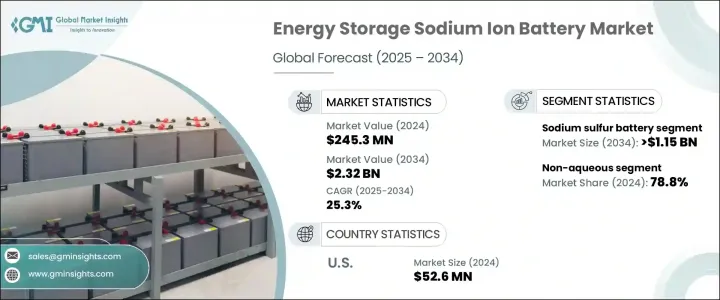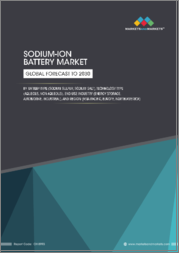
|
시장보고서
상품코드
1750444
세계의 에너지 저장용 나트륨 이온 전지 시장 : 기회, 성장 촉진요인, 산업 동향 분석, 예측(2025-2034년)Energy Storage Sodium Ion Battery Market Opportunity, Growth Drivers, Industry Trend Analysis, and Forecast 2025-- 2034 |
||||||
세계의 에너지 저장용 나트륨 이온 배터리 시장은 2024년 2억 4,530만 달러로 평가되었으며, 저렴한 가격으로 지속 가능한 에너지 저장 솔루션에 대한 수요가 증가함에 따라 CAGR 25.3%로 성장하여 2034년까지 23억 2,000만 달러에 이를 것으로 추정됩니다.
지구상에서 6번째로 풍부한 원소인 나트륨은 리튬을 대체하는 환경 친화적인 원소이며, 배터리 생산과 관련된 비용과 공급 체인의 과제를 경감합니다.

나트륨 이온 배터리는 태양광 및 풍력과 같은 재생에너지로부터의 잉여 에너지를 저장하고 피크시 수요에 중요한 백업 전력을 공급하기 때문에 전력망의 안정화에 점점 더 중요해지고 있습니다. 지속 가능하고 비용 효율적인 에너지 저장 솔루션에 대한 수요가 증가함에 따라 R&D 투자는 꾸준히 나트륨 이온 전지의 성능을 향상시키고 효율성과 내구성을 향상시키고 있습니다.
| 시장 범위 | |
|---|---|
| 시작 연도 | 2024년 |
| 예측 연도 | 2025-2034년 |
| 시작 금액 | 2억 4,530만 달러 |
| 예측 금액 | 23억 2,000만 달러 |
| CAGR | 25.3% |
나트륨 이온 전지 시장은 다양성이 풍부하고 특정 용도를 위해 여러 유형이 개발되고 있습니다. 이러한 배터리는 탁월한 에너지 밀도와 4,500사이클 이상의 긴 사이클 수명을 가지며 고온 작동이 필요한 거치형 에너지 저장 시스템에 이상적입니다.
비수용성 나트륨 이온 전지 분야도 시장의 성장에 크게 기여하고 있습니다.
북미 에너지 저장용 나트륨 이온 배터리 2024년 시장 점유율은 23.2%로 향후 수년간 대폭적인 성장이 예상됩니다. 안전보장과 보다 지속가능한 에너지 솔루션 개발에 전략적 우위성을 발휘합니다.
세계 에너지 저장용 나트륨 이온 배터리 시장의 주요 기업으로는 Faradion Limited, Northvolt, Tiamat, Altris, CATL 등이 있습니다. Limited와 Northvolt와 같은 나트륨 이온 전지 업계의 기업은 효율과 사이클 수명의 개선에 의한 전지 기술의 진보에 주력하고 있습니다. 이러한 기업은 에너지 저장 수요 증가에 대응하기 위해, 보다 지속 가능하고 비용 효율적인 솔루션을 개발하는 연구에 다액의 투자를 실시했습니다.
목차
제1장 조사 방법과 범위
제2장 주요 요약
제3장 업계 인사이트
- 업계 에코시스템
- 트럼프 정권의 관세 분석
- 무역에 미치는 영향
- 무역량의 혼란
- 보복조치
- 업계에 미치는 영향
- 공급측의 영향(원재료)
- 주요 원재료의 가격 변동
- 공급망 재구성
- 생산 비용에 미치는 영향
- 수요측의 영향(판매가격)
- 최종 시장에의 가격 전달
- 시장 점유율 동향
- 소비자의 반응 패턴
- 공급측의 영향(원재료)
- 영향을 받는 주요 기업
- 전략적인 업계 대응
- 공급망 재구성
- 가격 설정 및 제품 전략
- 정책관여
- 전망과 향후 검토 사항
- 무역에 미치는 영향
- 규제 상황
- 업계에 미치는 영향요인
- 성장 촉진요인
- 업계의 잠재적 위험 및 과제
- 성장 가능성 분석
- Porter's Five Forces 분석
- PESTEL 분석
제4장 경쟁 구도
- 소개
- 전략적 대시보드
- 혁신과 지속가능성의 정세
제5장 시장 규모와 예측 : 유형별, 2021-2034년
- 주요 동향
- 나트륨 유황 전지
- 나트륨 소금 전지
- 나트륨 공기 전지
제6장 시장 규모와 예측 : 기술별, 2021-2034년
- 주요 동향
- 수성
- 비수성
제7장 시장 규모와 예측 : 지역별, 2021-2034년
- 주요 동향
- 북미
- 미국
- 캐나다
- 유럽
- 독일
- 프랑스
- 영국
- 아시아태평양
- 중국
- 일본
- 한국
- 인도
- 세계 기타 지역
제8장 기업 프로파일
- Altris
- CATL
- China BAK Battery
- Faradion Limited
- HiNa Battery Technology
- Li-FUN Technology
- Northvolt
- Natron Energy
- SVOLT
- Tiamat
The Global Energy Storage Sodium Ion Battery Market was valued at USD 245.3 million in 2024 and is estimated to grow at a CAGR of 25.3% to reach USD 2.32 billion by 2034, driven by the increasing demand for affordable and sustainable energy storage solutions. Sodium, being the sixth most abundant element on Earth, offers an environmentally friendly alternative to lithium, reducing both the cost and supply chain challenges associated with battery production. Sodium-ion batteries are gaining popularity due to their safer properties, as they are less prone to overheating and thermal runaway, making them suitable for large-scale energy storage applications.

Sodium-ion batteries are becoming increasingly essential in stabilizing power grids, as they store excess energy from renewable sources such as solar and wind and provide critical backup power during peak demand periods. These batteries are especially valuable for grid-level energy storage, where their ability to handle long discharge cycles and deep cycling can make a significant impact. As the demand for sustainable and cost-effective energy storage solutions grows, investments in research and development are steadily improving the performance of sodium-ion batteries, enhancing their efficiency and durability. This progress positions sodium-ion batteries as a promising alternative for a variety of energy storage applications in the future.
| Market Scope | |
|---|---|
| Start Year | 2024 |
| Forecast Year | 2025-2034 |
| Start Value | $245.3 Million |
| Forecast Value | $2.32 Billion |
| CAGR | 25.3% |
The sodium-ion battery market is diverse, with several distinct types being developed for specific applications. The sodium-sulfur battery segment is expected to witness substantial growth, with projections indicating a market value of USD 1.15 billion by 2034. These batteries offer exceptional energy density and long cycle life, capable of more than 4,500 cycles, making them ideal for stationary energy storage systems that require high-temperature operation. Typically operating at temperatures ranging from 300°C to 350°C, sodium-sulfur batteries are particularly well-suited for large-scale grid-level storage and backup power systems, where efficiency and reliability are critical.
The non-aqueous sodium-ion battery segment is another key contributor to the market's growth. These batteries, which account for 78.8% share in 2024, are favored for their enhanced temperature tolerance and superior energy performance compared to other battery types. Their ability to operate in diverse environments, ranging from grid storage to mobility applications, makes them a versatile and highly desirable solution for energy companies and electric vehicle manufacturers.
North America Energy Storage Sodium Ion Battery Market held a 23.2% share in 2024 and is expected to grow significantly in the coming years. Sodium-ion batteries are gaining traction as a cost-effective and domestically produced alternative to lithium-ion batteries, dependent on imports. The abundant availability of sodium, combined with its relatively lower cost, provides a strategic advantage in energy security and the development of more sustainable energy solutions. This growing interest in sodium-ion batteries underscores their potential to transform the energy storage landscape by reducing reliance on imported materials and enhancing the overall sustainability of the energy sector.
Leading companies in the Global Energy Storage Sodium Ion Battery Market include Faradion Limited, Northvolt, Tiamat, Altris, and CATL. These companies are actively developing new technologies to enhance the performance, scalability, and safety of sodium-ion batteries for large-scale energy storage applications. To strengthen their market presence, companies in the sodium-ion battery industry, such as Faradion Limited and Northvolt, are focusing on advancing their battery technologies by improving efficiency and cycle life. They are investing heavily in research to develop more sustainable and cost-effective solutions to meet the growing demand for energy storage. Additionally, strategic partnerships with renewable energy providers and government-backed initiatives are helping these companies expand their market footprint.
Table of Contents
Chapter 1 Methodology & Scope
- 1.1 Research design
- 1.2 Base estimates & calculations
- 1.3 Forecast model
- 1.4 Primary research & validation
- 1.4.1 Primary sources
- 1.4.2 Data mining sources
- 1.5 Market definitions
Chapter 2 Executive Summary
- 2.1 Industry synopsis, 2021 - 2034
Chapter 3 Industry Insights
- 3.1 Industry ecosystem
- 3.2 Trump administration tariff analysis
- 3.2.1 Impact on trade
- 3.2.1.1 Trade volume disruptions
- 3.2.1.2 Retaliatory measures
- 3.2.2 Impact on the industry
- 3.2.2.1 Supply-side impact (raw materials)
- 3.2.2.1.1 Price volatility in key materials
- 3.2.2.1.2 Supply chain restructuring
- 3.2.2.1.3 Production cost implications
- 3.2.2.2 Demand-side impact (selling price)
- 3.2.2.2.1 Price transmission to end markets
- 3.2.2.2.2 Market share dynamics
- 3.2.2.2.3 Consumer response patterns
- 3.2.2.1 Supply-side impact (raw materials)
- 3.2.3 Key companies impacted
- 3.2.4 Strategic industry responses
- 3.2.4.1 Supply chain reconfiguration
- 3.2.4.2 Pricing and product strategies
- 3.2.4.3 Policy engagement
- 3.2.5 Outlook and future considerations
- 3.2.1 Impact on trade
- 3.3 Regulatory landscape
- 3.4 Industry impact forces
- 3.4.1 Growth drivers
- 3.4.2 Industry pitfalls & challenges
- 3.5 Growth potential analysis
- 3.6 Porter's analysis
- 3.6.1 Bargaining power of suppliers
- 3.6.2 Bargaining power of buyers
- 3.6.3 Threat of new entrants
- 3.6.4 Threat of substitutes
- 3.7 PESTEL analysis
Chapter 4 Competitive landscape, 2024
- 4.1 Introduction
- 4.2 Strategic dashboard
- 4.3 Innovation & sustainability landscape
Chapter 5 Market Size and Forecast, By Type, 2021 - 2034 (USD Million)
- 5.1 Key trends
- 5.2 Sodium sulfur battery
- 5.3 Sodium salt battery
- 5.4 Sodium air battery
Chapter 6 Market Size and Forecast, By Technology, 2021 - 2034 (USD Million)
- 6.1 Key trends
- 6.2 Aqueous
- 6.3 Non aqueous
Chapter 7 Market Size and Forecast, By Region, 2021 - 2034 (USD Million)
- 7.1 Key trends
- 7.2 North America
- 7.2.1 U.S.
- 7.2.2 Canada
- 7.3 Europe
- 7.3.1 Germany
- 7.3.2 France
- 7.3.3 UK
- 7.4 Asia Pacific
- 7.4.1 China
- 7.4.2 Japan
- 7.4.3 South Korea
- 7.4.4 India
- 7.5 Rest of World
Chapter 8 Company Profiles
- 8.1 Altris
- 8.2 CATL
- 8.3 China BAK Battery
- 8.4 Faradion Limited
- 8.5 HiNa Battery Technology
- 8.6 Li-FUN Technology
- 8.7 Northvolt
- 8.8 Natron Energy
- 8.9 SVOLT
- 8.10 Tiamat



















